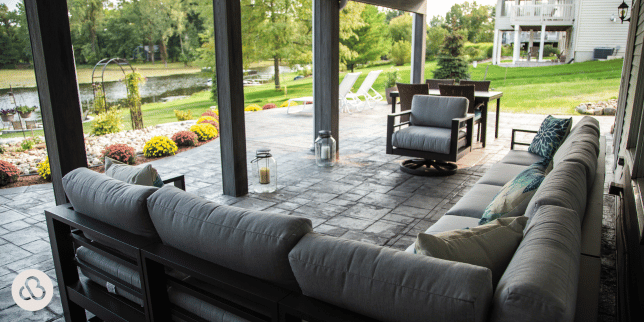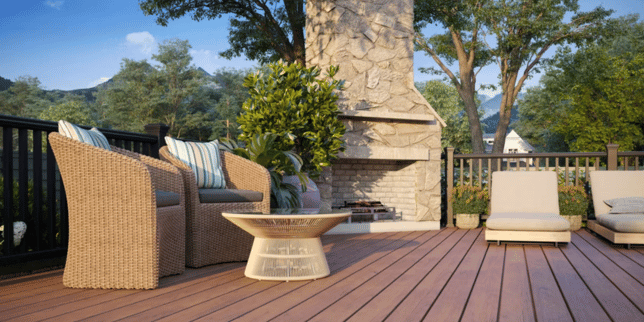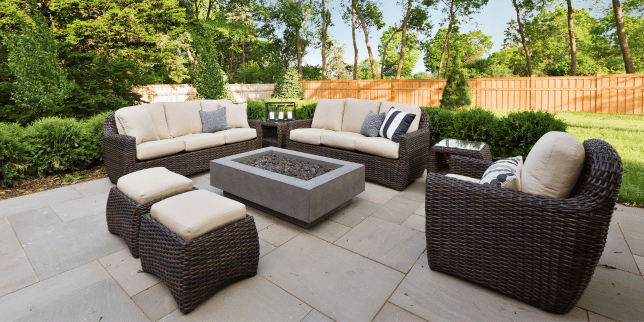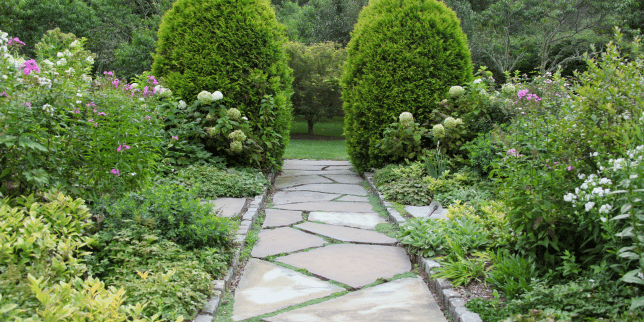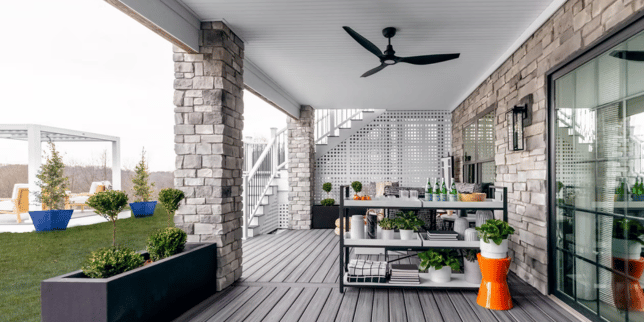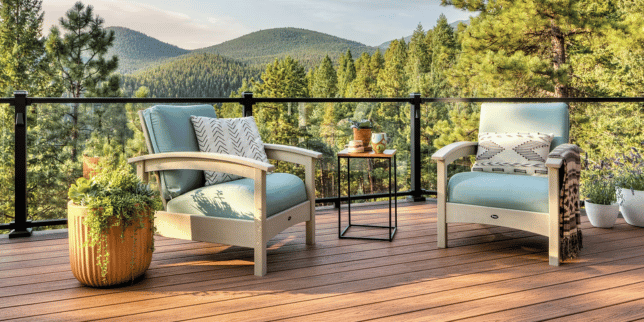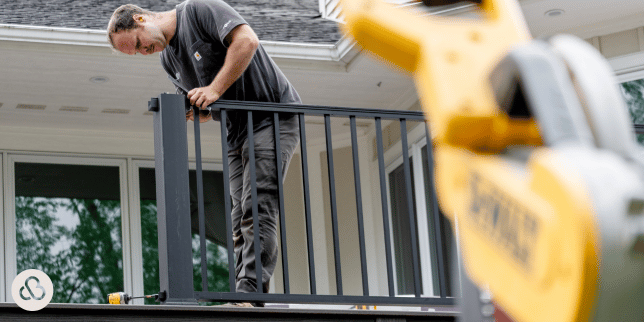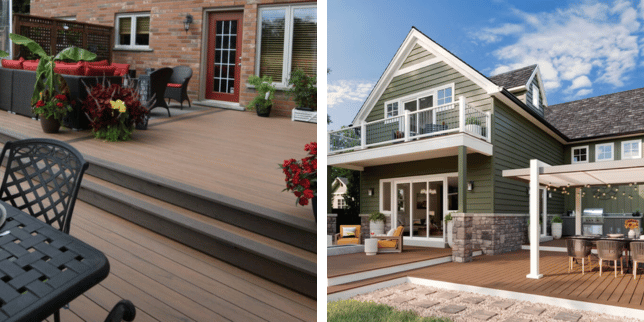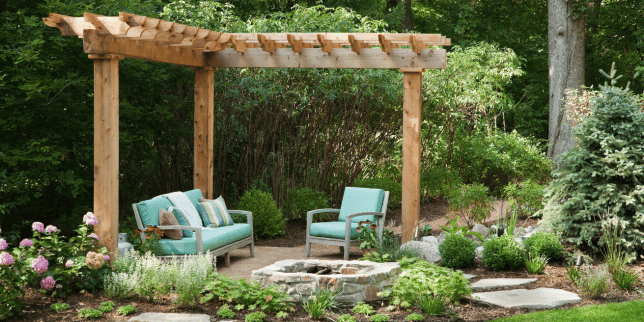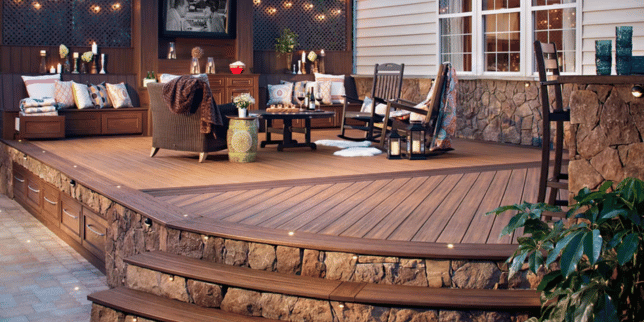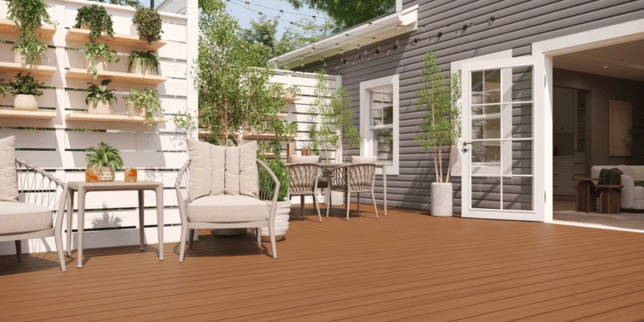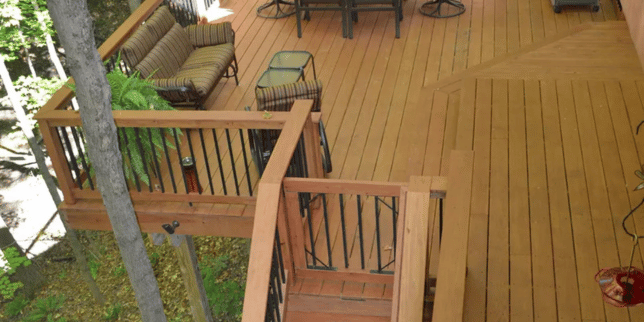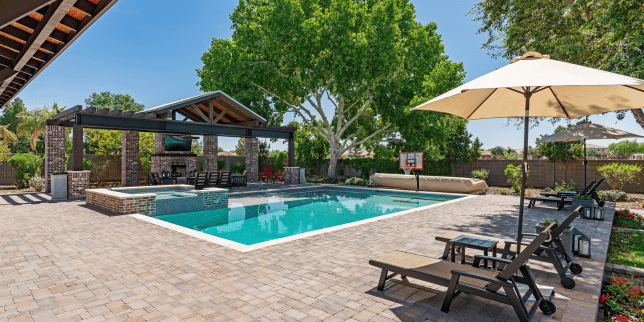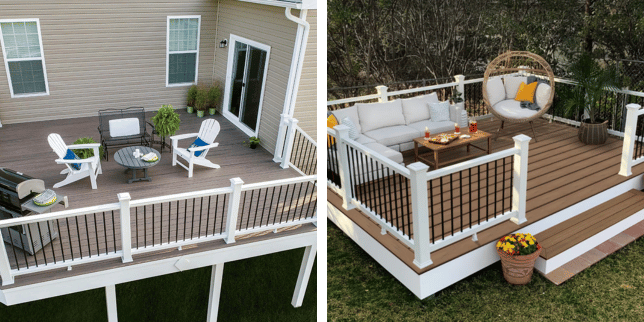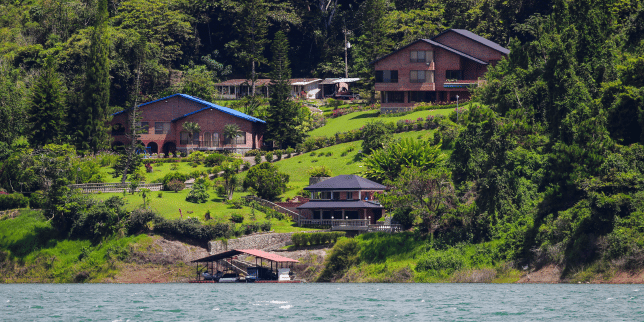10 Things to Consider While Designing Your Deck
February 16th, 2024
7 min read
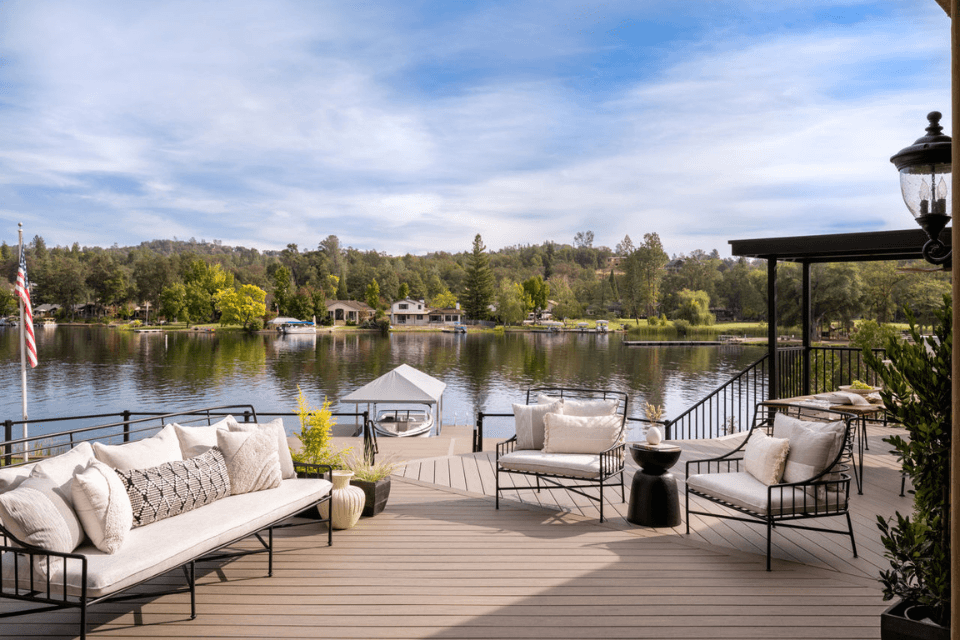
Are you envisioning a deck perfect for hosting dinners or relaxing with a glass of wine? Are you ready to build a gorgeous outdoor living space but don’t know where to start with your design?
Creating an outdoor space that integrates with your home and meets your preferences is appealing. Yet, designing a deck has various complexities that can be confusing to keep track of and follow appropriately.
At Custom Built, we understand the significance of this challenge. With 15+ of experience in crafting outdoor spaces, we have guided many homeowners through the intricate deck design process.
In this article, you will gain invaluable insights into every facet of designing your deck:
- Integration with Home Architecture
- Zoning and Setbacks
- Space Usage and Functionality
- Material Selection
- Budget Planning
- Functional Design Elements
- Michigan Climate Considerations
- Safety Measures
- Future Maintenance
- Trends and Innovations
1. Integration with Home Architecture
When planning your deck, consider how it fits within your home's design.
Start by determining your existing back or side door’s placement and how it leads to the deck. This will dictate where your indoor space will transition into your outdoor space. However, if you’re planning to add a new door altogether, your design will include a different entrance/exit location instead.
Additionally, think about how you want to access your yard. Is it through the backyard or sideyard? Some homeowners prefer no steps for security reasons. Defining the level of accessibility you would like your deck to have is a great place to begin
Here are some more ways you can decide how to design your deck to integrate with your home architecture:
- Architectural Harmony: Choose deck materials, colors, and shapes that align with your home's design. Consistency in architectural elements enhances visual appeal and creates a unified look.
- Integrate Existing Structures: If you have patios or outdoor features, find ways to integrate the deck with these elements. Cohesive design enhances the aesthetic and functionality of your outdoor space.
- Privacy and Boundaries: Define your preferences for privacy and boundaries. Incorporate features like built-in privacy walls or landscaping. This will create a harmonious transition between indoor and outdoor spaces.
- Door Addition Possibilities: Explore the possibility of adding doors to help direct access to the deck. This step can influence the deck's location and layout. Additionally, it will enhance its integration with your home's architecture.
- Sun Exposure and Time of Day: Consider the sun's movement and exposure at different times. This knowledge helps determine the deck's orientation to maximize sunlight or provide shade. Think of your preferences for morning, afternoon, or evening use.
2. Zoning and Setbacks
Navigating zoning regulations and setbacks is a critical step in the deck design process. Each municipality has specific rules, and setbacks determine how close your deck can be to the property line.
For instance, fire regulations may call for flame-retardant coating on materials if your deck extends beyond the building limits. Knowing these rules is vital.
Follow the tips below to understand zoning and setback rules as you plan your deck design:
- Work Within Property Limitations: Recognize the building boundaries and rules. Ensure your deck plan fits within these limits to prevent issues with neighbors and authorities.
- Research Municipal Regulations: Research the zoning and setback regulations imposed by your municipality. This knowledge provides a foundation for designing a deck that complies with local requirements.
Custom Built Pro Tip: With every outdoor living project we take on, our clients get a survey to ensure we stay within the regulations.
3. Space Usage and Functionality
Understanding intended usage is key to designing a deck that meets your needs.
Consider the number of people you envision hosting and your preferred entertaining method. Is the deck a central part of your gatherings, and do you foresee it being a dining or lounging area?
Also, consider the time of day you'll use it and whether you plan to include features like a fire pit. These considerations will influence the size and layout of your deck.
Here are more questions to ask yourself while evaluating how you want to use your new deck:
- Outdoor Cooking Preferences: Do you enjoy outdoor cooking? Incorporate a grill or an outdoor kitchen into your deck design.
- Desired Privacy Level: How important is privacy to you? Consider adding built-in privacy walls, windscreens, or other features to enhance the seclusion of your deck.
- Potential Additions: Will you add features like a hot tub or permanent countertops? Account for extra weight and structural considerations during the initial design phase.
- Deck Accessibility: How do you want to access the yard from your deck? Plan the location of stairs and their design based on your desired flow between the deck and the surrounding landscape.
4. Material Selection
Choosing the suitable materials for your deck involves weighing various options.
Explore natural wood products like treated, cedar, or exotic wood like Ipe. Or, consider composite materials, offering durability and lower maintenance. Each material has its characteristics, and factors like climate and budget play a role in making an informed decision.
Discover more deck cost range details via our video below:
5. Budget Planning
Budget planning is a crucial aspect of the deck design process. The size of your deck significantly contributes to costs, and considerations such as stairs, complexity, and geometry can impact your budget.
Here are more ways your design choices will affect your budget:
- Built-in Features: Integrating benches, seating areas, or planters adds customization. But, this can contribute to higher costs due to more materials and labor.
- Foundation and Structure: Deck height and elevation affect your foundation and structure's complexity. Elevated decks may need extra support structures, leading to increased costs.
- Railing Choices: Railing materials can impact aesthetics and costs. Ornate or custom-designed railings will incur extra expenses compared to simple, standard options. For example, glass deck railings cost $150 - $600 per linear foot (including labor), in contrast to cedar railings, which cost $30 - $50 per linear foot.
6. Functional Design Elements
Enhancing the functionality of your deck involves thoughtful consideration of design elements. Built-in benches, privacy walls, multi-tier decks, and fire tables can impact the usability of your outdoor space.
Here are more functional design elements to consider:
- Outdoor Entertainment Setup: Built-in speakers, TV mounts, or dedicated spaces for entertainment systems.
- Specialty Design Areas: Nooks, alcoves, or special seating areas will add character and charm to the deck layout.
- Custom Lighting: Enhance safety and ambiance with installed lighting. Consider built-in step lighting, post lights, or path lights.
- Outdoor Kitchen: Include a designated area with countertops for preparing meals. This feature is ideal for those who enjoy grilling or hosting outdoor gatherings.
- Water Features: For a tranquil ambiance, consider integrating features like fountains or waterfalls. These elements can enhance the aesthetics and create a soothing environment.
- Hot Tub or Spa: Plan a built-in space to accommodate a hot tub or spa. Ensure the deck structure can support the extra weight. Also, consider integrating steps or access points for convenience.
7. Michigan Climate Considerations
Designing a deck that withstands Michigan's climate challenges is crucial for longevity. Factors like sun exposure, drainage, and freeze-thaw cycles need consideration.
For instance, because of Michigan’s snowy climate, you must account for snow and ice sitting on your deck during certain times of the year. Understanding these Michigan climate considerations ensures your deck stands up to the elements:
- Wind Exposure: Consider the prevailing wind patterns in the area when designing the deck. Position features like privacy walls or windbreaks to protect from strong winds. This enhances comfort and prevents potential wind damage to furniture or other deck elements.
- Drainage: Assess the drainage conditions in the deck area. Plan for efficient water runoff to prevent pooling and potential water damage. Install slopes and drainage systems, like under-deck drainage systems or rain diversion features. This will direct water from the deck structure.
- Temperature Swings: Consider the temperature extremes experienced in the local climate. Recognize the impact of temperature swings, including hot summers and cold winters, on deck materials. Choose materials that can withstand these fluctuations without compromising structural integrity or aesthetics.
8. Safety Measures
Prioritizing safety measures is paramount in deck design. Well-defined steps with lighting and graspable railings contribute to a secure deck environment.
Additionally, think of the following safety measures to include in your deck design:
- Even Surfaces: Cut changes in deck levels to reduce the risk of accidents.
- Clear Walkways: Maintain unobstructed walkways for safe movement on the deck.
- Childproof Features: Consider safety gates or barriers for families with young children.
- Safe Furniture Placement: Arrange furniture to avoid creating tripping hazards or obstructing pathways.
- Slip-Resistant Decking Material: Choose materials with anti-slip properties to prevent accidents.
9. Future Maintenance
Thinking ahead about maintenance is essential for the long-term care of your deck. Generally, natural wood decks may need regular sealing, while composite decks need less maintenance.
Here are more future maintenance considerations you should keep in mind while designing your deck:
- Pest Control Measures: Consider preventative measures to address potential pest issues.
- UV Protection: Explore options for UV-resistant finishes to shield the deck from sun-related damage.
- Seasonal Adjustments: Plan for seasonal adjustments or treatments, like protective coatings, before winter.
- Cleaning and Mold Prevention: Plan for regular cleaning routines, especially in humid climates. This will prevent mold and mildew.
- Trim and Structural Checks: Inspect and maintain deck trim, railings, and structural components for any signs of wear or damage.
- Inspection and Repairs: Factor in periodic inspections and potential repairs to address wear and tear. This ensures the deck remains in optimal condition over time.
10. Trends and Innovations
Staying updated on the latest trends and innovations adds a modern touch to your deck design. Check out different materials, shapes, custom designs, and varied textures that add to the modern look. For more ideas, see the list below for trends influencing deck design, helping you make a trendy and current outdoor space.
- Floating Decks: Opt for a contemporary look with a floating deck hanging above the ground.
- Mixed Materials: Experiment combining wood, metal, and stone to add texture and interest.
- Vertical Gardens: Incorporate vertical gardens or green walls for a sustainable deck design.
- Glass Railings: Achieve a sleek and unobstructed view with glass railings, providing a modern touch.
- Curved and Angled Designs: Embrace curved or angled deck shapes for a unique and modern aesthetic.
Next Steps to Designing Your Deck
If you began this exploration feeling daunted by the prospect of designing your deck, you're not alone. The many decisions, from material choices to zoning considerations, can be overwhelming.
Through our shared expertise and your newfound knowledge, you now have the tools to approach deck design with confidence.
At Custom Built, our 15+ years of deck-building experience has yielded hundreds of outdoor living space designs.
Your next steps involve translating this knowledge into action. Consider contacting our team for personalized guidance, ensuring that your deck project unfolds. Whether it's a cozy space for family gatherings or a stylish setting for entertaining, the deck of your dreams is within reach.
Now that you know more about the common issues with replacing deck boards, explore how Custom Built will approach your project, how much your new outdoor living space will cost, and how long it’ll take to build:
- Dream, Design, and Build: Our Remodeling Process - This guide details how we at Custom Built will approach your remodeling project.
- How Much Do Composite Decks Cost in Lansing, Michigan? - An overview of how much your Lansing composite deck will cost and the factors that will influence your price.
- How Long Does it Take to Build a Deck (Factors that Affect Timeline) - Explore details that affect how long it takes to build your composite deck with Custom Built’s Proven Process as the foundation.
Jacob brings 20+ years of residential construction experience to the Custom Built team. He has spent years in the field learning the hands-on side of building from foundation prep to roofing shingles. With a need-to-know mindset and a desire to understand how things work, Jacob has studied building science, systems integration, home inspection, and radon measurement and mitigation.












